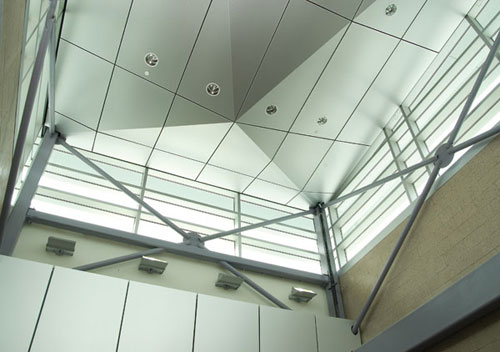Form Follows Fun: Design Options in Modern Ceiling and Wall Systems
 |
Facetted ceiling, rising above the Tompkins Community College in Dryden, NY, repeats polygonal form of structural cross bracing. BIM-compatible fabrication was used to form the folds in the metal panels. Designed by JMZ Architects and Planners, P.C., |
While there are some non-orthogonal examples, such as Frank Lloyd Wright's experiments with hexagonal modules in his Usonian houses and Buckminster Fuller's geodesic and Dymaxion projects, rectangles were the dominant planning module of the architectural era now drawing to a close. The rectitude of rectilinearity was boldly proclaimed during the post-World War II era by legions of great steel-and-glass boxes with gridded facades that sprang up on expensive real estate in most of the cities of the Western world. Ceilings still bear glaring evidence of this trend in the nearly ubiquitous use of the 24 x 48-in. lay-in grid system.
New technologies have brought dreaming back into architecture by redefining what is practical to build. Computer-aided design (CAD) and building information modeling (BIM) require only a modicum of additional computing power to define curved and tessellated shapes instead of orthogonal shapes. Innovative designers can now write algorithms based on building-program requirements - such as access to sunlight or audience sightlines - and then use computational analysis to suggest "generative designs" not constrained by historical building forms.
Fabrication is done by machines thatdon't care if they make the same shape repeatedly, or a different shape on every panel. BIM information is linked to computer-numerically controlled (CNC) metal-forming equipment, so ceiling systems composed of digitally created shapes are made with little or no cost increase over standardized shapes. The BIM/CNC connection has effectively erased the distinction between standard and custom fabrication and ushered in the era of "mass customization." This capability extends to fabricating perforations as well as panel shapes and sizes. With BIM-driven fabrication, every panel can be a different shape.
The minimal weight of light gage metal panels overcomes the earlier problems of suspending heavy materials. Aluminum ceiling panel systems made of .040-inch thick sheet can weigh, including support system, as little as one half the load of a mineral-fiber panel system. Moreover, wood panels can now be made by laminating ultra-thin wood veneers to sheet aluminum instead of wood-product cores. This gives wood ceilings and walls all the options in shaping and forming that apply to metal panels, and improves their performance affordably. (See sidebar, "The New Wood")
The result is that patterns based on triangles, pentagons, trapezoids, and other polygons have become economically feasible alternatives to the square and rectangular grids. The designer can create patterns with shapes, with curvatures, with perforation patterns, with varying planes, and with combinations of these variables. The wide range of tessellations is now within reach.









